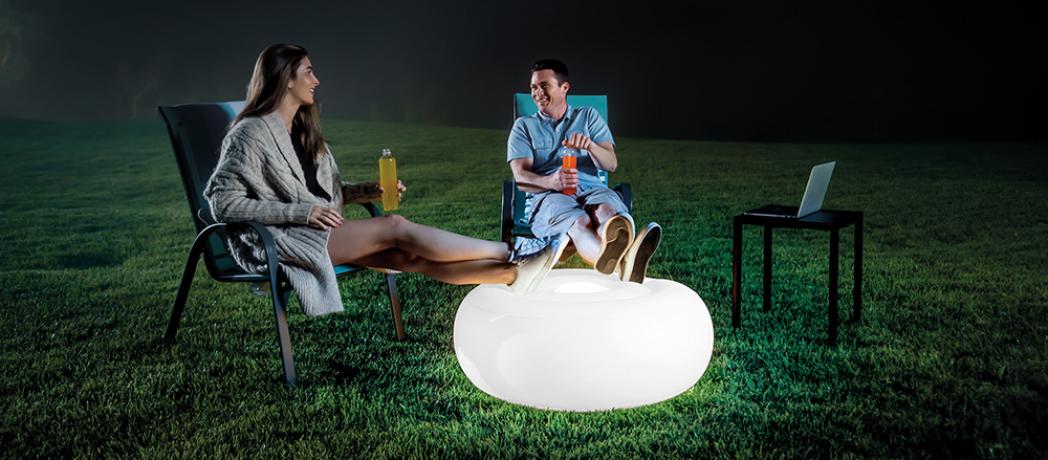
To make a success of outdoor lighting, list your needs beforehand. Some integrations that require a connection to the electrical network must be decided sometimes, before the construction of a terrace. Solar powered lights are certainly popular for economic and ecological reasons, but they cannot replace the reliability of a traditional and functional lighting: the light, stored during the day, is restored at nightfall, but the duration of the lighting is limited in time and depends on its exposure to natural light.
The lighting of an outdoor space is not the same as inside a house. We light the vegetal or mineral materials and we underline the spaces. We light the functions but we leave shadow areas… But the lights can also play a dual role. A wall light can illuminate a passage while highlighting the stone of a building. On the other hand, it is necessary to choose an index of protection adapted to the positioning of the luminaries. Near the house, an IP rating of 24 is sufficient. In the garden, for a good resistance to rain and dust, we move to an index 44. For a waterproof luminaire, choose an IP 67 or even 69 if it is immersed for a long time.
Outside, it is also very important to combine light sources. On the practical side, think of nomadic and multifunctional lights, such as hand lamps and wireless models that run on solar energy or a battery that can be recharged from the mains. Dimmers built into lights are very useful for varying their power according to the decline of natural light. Don’t forget presence detectors, models equipped with remote control and the help of home automation, which, thanks to an application on smartphone, allows you to control and manage a whole network of lights.
And then, you can always add candles and candle holders to create a more poetic and romantic atmosphere. As for the light source, the LED bulb that consumes ten times less electricity than a compact fluorescent lamp is recommended. The latter is certainly the most economical to purchase but does not deliver, from the moment it is turned on, 100% of the luminous flux as the LED which also offers 40,000 to 50,000 hours of light at full output (which means that afterwards, it will light up less but will not be turned off all at once) and does not heat up.
Finally, there are three types of color temperature. Expressed in kelvins, the higher the number, the whiter and colder the light. The cold white, giving a bluish light, is adapted to the lighting of a particular element of the garden or to the marking of a path. Warm white, with a yellow-orange light, is suitable for a dining table or a relaxation area. Neutral white is ideal for lighting a terrace, an entrance or stairs. As for the yellowish white, it is simply decorative and is close to candlelight.
The design
The trend is towards elementary, geometric and architectural forms that are declined in several models to adapt to different living scenarios. Flexible light tubes, able to articulate in space or archetypal forms that are placed, suspended or fixed to poles of different heights, they blend into the space in minimalist diffusers hiding their light sources. Outdoor lights are also inspired by everyday objects to discreetly blend into the outdoor decor. Natural materials, concrete, bamboo or durable thermoplastics, simplicity expresses itself to give full life to the function.
General lighting
It is the guarantor of the general atmosphere of the garden. With low intensity, the light points are positioned every two to four meters, with, for example, solar beacons that are planted in the ground or placed on a low wall, or luminaires embedded in the ground. The whole must wrap the space of a soft luminous atmosphere not to dazzle or disorientate. Count on 60 to 80 lumens per m2, while to read and work you need 150 lumens (unit that measures the amount of light, editor’s note) for the same surface.
Communication areas
At the entrance, lighting is used to welcome visitors, to identify the aisles and to ensure their safety. Aisles should be highlighted rather than lit, so be careful with overly aggressive lighting. Prefer a warm and soothing white tone. For a discreet solution, you can use small LEDs positioned at ground level and invisible during the day or simply trace a path with a luminous ribbon, a very economical alternative. Spotlights, bollards or posts to be planted are more present but do not clutter the landscape. If the path is lined with trees, you can hang a garland, which can also run between poles.

